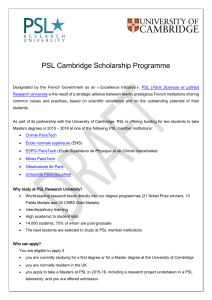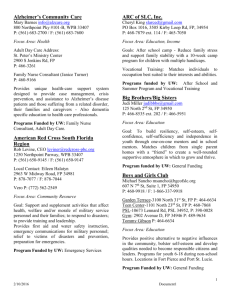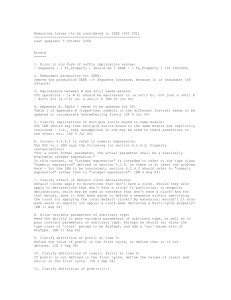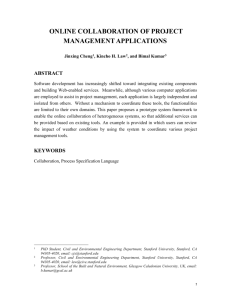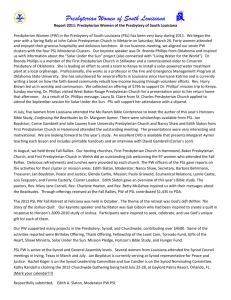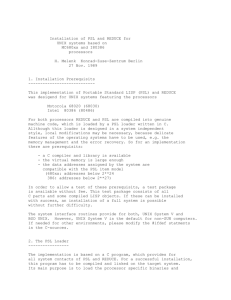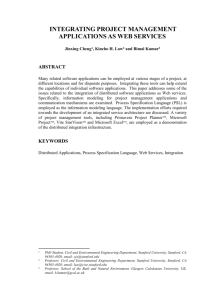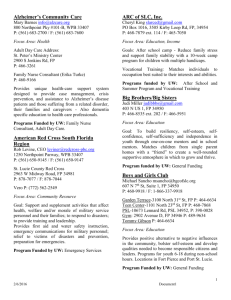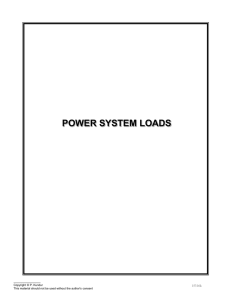PSL_Paper - Engineering Informatics Group
advertisement
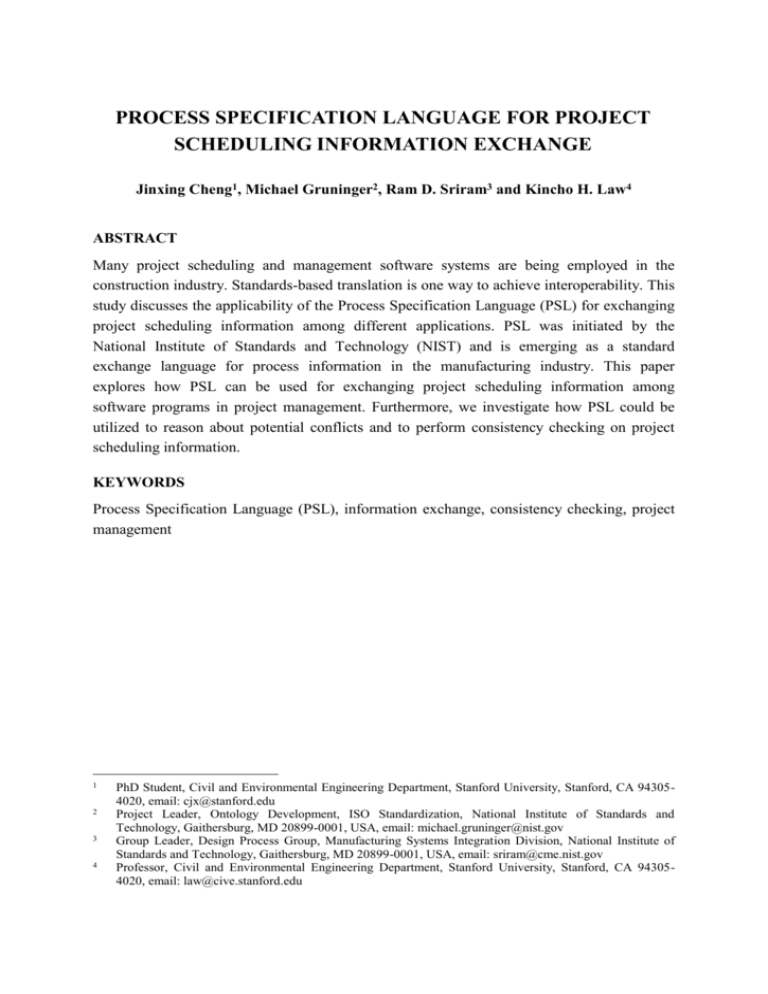
PROCESS SPECIFICATION LANGUAGE FOR PROJECT
SCHEDULING INFORMATION EXCHANGE
Jinxing Cheng1, Michael Gruninger2, Ram D. Sriram3 and Kincho H. Law4
ABSTRACT
Many project scheduling and management software systems are being employed in the
construction industry. Standards-based translation is one way to achieve interoperability. This
study discusses the applicability of the Process Specification Language (PSL) for exchanging
project scheduling information among different applications. PSL was initiated by the
National Institute of Standards and Technology (NIST) and is emerging as a standard
exchange language for process information in the manufacturing industry. This paper
explores how PSL can be used for exchanging project scheduling information among
software programs in project management. Furthermore, we investigate how PSL could be
utilized to reason about potential conflicts and to perform consistency checking on project
scheduling information.
KEYWORDS
Process Specification Language (PSL), information exchange, consistency checking, project
management
1
2
3
4
PhD Student, Civil and Environmental Engineering Department, Stanford University, Stanford, CA 943054020, email: cjx@stanford.edu
Project Leader, Ontology Development, ISO Standardization, National Institute of Standards and
Technology, Gaithersburg, MD 20899-0001, USA, email: michael.gruninger@nist.gov
Group Leader, Design Process Group, Manufacturing Systems Integration Division, National Institute of
Standards and Technology, Gaithersburg, MD 20899-0001, USA, email: sriram@cme.nist.gov
Professor, Civil and Environmental Engineering Department, Stanford University, Stanford, CA 943054020, email: law@cive.stanford.edu
1 INTRODUCTION
As the use of information technology increases in the construction industry, the need for
software applications to interoperate has become increasingly important. With the variety of
construction applications that can be employed in a construction project, large volumes of
project information are created from different sources. Different members of a project team
may use different application software for disparate purposes; examples may include
Primavera Project PlannerTM (P3) or Microsoft ProjectTM for scheduling, Vite SimVisionTM for
project organization, Timberline’s Precision EstimatingTM for estimating cost, and 4D Viewer
(McKinney and Fischer 1998) for the view of construction progress. It is not unusual that
project data are re-entered from one application to another.
To achieve interoperability, computer applications need to agree on a standard ontology.
An ontology is an explicit specification of a topic that includes a set of terms and the
relationships among these terms (Guarino 1997). Ontologies can be represented in many
ways. Examples include graphical notations (e.g. UML) and logic-based representations (e.g.
KIF). Currently, many product models and data standards, such as STEP (ISO 1994), IFC
(IAI 1997), and aecXML (IAI 2002), exist to provide interoperability among different
applications in the AEC domain. Examples include: (1) a product model for roofing systems
developed using STEP (Vanier 1998); (2) the CIMsteel project, in which product modeling
and data exchange for the construction steelwork industry was accomplished with STEP
(Garas and Hunter 1998); (3) the use of Unified Modeling Language (UML) to represent
product and process information in steelwork construction projects (Anumba et al. 2000); and
(4) an IFC-based model to exchange information about maintenance management (Hassanain
et al. 2000). Most of these existing standards focus, however, more on product data than on
process information.
Standards for business process and workflow information have also been proposed to
achieve interoperability in workflow management. For example, the Business Process
Modeling Language (BPML) was proposed as a meta-language to model business processes
(Arkin 2002). The Workflow Management Coalition (WFMC) has developed standards to
enable the interoperability among multiple workflow software products (Fischer 2002).
However, these languages cannot be directly applied for the exchange of process information
in manufacturing or construction applications. The Process Specification Language (PSL) was
designed specifically for exchanging process information among manufacturing applications
(ISO 2003) and is currently undergoing a standardization process at the international level. In
this paper, we evaluate the effectiveness of using PSL for the exchange of process
information in construction management applications.
In addition to interoperability, maintaining the consistency of project information also
poses a challenge since project information can come from various sources. In a complex
2
project, a tremendous amount of information is being exchanged among the different project
participants and software applications. Controlling the information flow and ensuring the
validity of information exchanged between computer applications are among the challenges
in project management. For example, in a distributed engineering environment, one project
team may choose to use Primavera Project PlannerTM, while Microsoft ProjectTM is preferred
by another for project scheduling. With multiple project participants utilizing different
software applications, conflicts may arise due to partial changes, miscommunications, etc.
Presently, there is no systematic approach to check the consistency of the scheduling
information from different applications.
Few solutions have been considered for solving the data inconsistency problem. For
example, a central database can be used as the common repository for different applications
to maintain data persistency and consistency, such as the approach adopted for the
Collaborative Dynamic Project Management (CDPM) system (Penã-Mora and Dwivedi
2002). However, this centralized database approach only partially solves the consistency
problem in that while it eliminates version conflicts, it does not address any logic conflicts.
Heuristic approaches have also been proposed, such as the 4D WorkPlanner Time-Space
Conflict Analyzer (4D TSConAn), for categorizing and detecting spatial conflicts (Akinci et
al. 2002). It is difficult, however, to generalize such heuristic approaches to handle the
conflicts that are outside the defined domain problem.
The Process Specification Language (PSL) provides a logic-based representation, which is
not only useful for the exchange of process information between application software, but
also potentially useful for discovering and resolving conflicts. This study evaluates the
applicability of PSL as an interchange language for construction project management
applications, and explores the mechanism of using PSL to maintain the consistency of the
project knowledge base.
This paper is organized as follows: Section 2 briefly introduces PSL and discusses the
motivation and the major components of PSL. Mapping the concepts between PSL and
project management applications is discussed in Section 3. Section 4 describes the parser and
the wrappers developed for the exchange of project scheduling information using PSL.
Section 5 discusses the potential use of PSL for consistency checking using a logic-based
reasoning tool. Examples on information exchange and consistency checking are given in
Section 6 to demonstrate the current prototype environment. Finally, Section 7 summarizes
the results described in this paper.
2 INTRODUCTION TO PSL
Representing activities and the constraints on their occurrences is an integral aspect of
commonsense reasoning, particularly in project management, enterprise modeling, and
manufacturing. In addition to the traditional concerns of knowledge representation and
3
reasoning, the need to integrate software applications in these areas has become increasingly
important. However, interoperability is hindered because the applications use different
terminology and representations of the domain. These problems arise most acutely for
systems that must manage the heterogeneity inherent in various domains and integrate models
of different domains into coherent frameworks. For example, such integration occurs in
business process reengineering, where enterprise models integrate processes, organizations,
goals, and customers. Even when applications use the same terminology, they often associate
different semantics with the terms. This clash over the meaning of the terms prevents the
seamless exchange of information among the applications. Typically, point-to-point
translation programs are written to enable communication from one specific application to
another. However, as the number of applications has increased and the information has
become more complex, it has been more difficult for software developers to provide
translators between every pair of applications that must cooperate. What is needed is some
way of explicitly specifying the terminology of the applications in an unambiguous fashion.
The Process Specification Language (PSL) has been designed to facilitate correct and
complete exchange of process information among manufacturing systems (Schlenoff et al.
1999b, Menzel and Gruninger 2001)5. Included in these applications are scheduling, process
modeling, process planning, production planning, simulation, project management, workflow,
and business process reengineering. This section gives a brief overview of PSL; detailed
description of PSL can be found in the PSL specification (ISO 2003).
The PSL Ontology is a set of first-order theories organized into PSL-Core and a partially
ordered set of extensions. All extensions within PSL are consistent extensions of PSL-Core,
although not all extensions within PSL need be mutually consistent. Also, the core theories
need not be conservative extensions of other core theories. A particular set of theories is
grouped together to form the Outer Core; this is only a pragmatic distinction, since in
practice, they are needed for axiomatizing all other concepts in the PSL ontology. The
relationships among the core theories are depicted in Figure 1.
The purpose of PSL-Core is to axiomatize a set of intuitive semantic primitives that is
adequate for describing the fundamental concepts of manufacturing processes. Consequently,
this characterization of basic processes makes few assumptions about their nature beyond
what is needed for describing those processes, and the Core is therefore rather weak in terms
of logical expressiveness. Specifically, the Core ontology consists of four disjoint classes:
activities, activity occurrences, timepoints, and objects. Activities may have zero or more
occurrences, activity occurrences begin and end at timepoints, and timepoints constitute a
5
PSL has been accepted as project ISO 18629 within the International Organisation of Standardisation, and as of
October 2002, part of the work is under review as a Draft International Standard. The complete set of axioms for
the PSL Ontology can be found at {http://www.mel.nist.gov/psl/psl-ontology/}.
4
linearly ordered set with endpoints at infinity. Objects are simply those elements that are not
activities, occurrences, or timepoints.
Activity
Occurrences
Complex Activities
Atomic Activities
Subactivity
Discrete State
Occurrence Trees
PSL-Core
Figure 1. Core Theories of the PSL Ontology
PSL-Core is not strong enough to provide definitions of the many auxiliary notions that
become necessary to describe all intuitions about manufacturing processes. To supplement the
concepts of PSL-Core, the ontology includes a set of extended theories that introduce new
terminology. These Outer Core theories provide the logical expressiveness to axiomatize
intuitions involving concepts that are not explicitly specified in PSL-Core. The basic Outer
Core theories include Occurrence Trees, Discrete States, Subactivities, Atomic Activities,
Complex Activities, and Activity Occurrences. An Occurrence Tree is the set of all discrete
sequence of activity occurrences. Discrete States denote states and their relationships to
activities. Subactivities are defined to represent an ordering for aggregations of activities.
Atomic Activities are defined to capture concurrent aggregation of primitive activities.
Complex Activities characterize complex activities and the relationship between occurrences
of an activity and occurrences of its subactivities. Activity Occurrences ensure that complex
activity occurrences correspond to branches of activity trees. The remaining core theories in
the PSL Ontology include: Subactivity Occurrence Ordering (axiomatizing different partial
orderings over subactivity occurrence), Iterated Occurrence Ordering (axioms necessary for
defining iterated activities), Duration (augmenting PSL-Core with a metric over the timeline),
and Resource Requirements (which specifies the conditions that must be satisfied by any
object that is a resource for an activity).
5
Table 1. Definitional extensions of PSL
Definitional Extensions
Activity Extensions
Core Theories
Complex Activities
Example Concepts
Deterministic/nondeterministic
activities
Concurrent activities
Partially ordered activities
Temporal and State
Extensions
Complex Activities
Preconditions
Discrete States
Effects
Conditional activities
Triggered activities
Activity Ordering and
Duration Extensions
Resource Role
Extensions
Subactivity Occurrence Ordering
Complex sequences and branching
Iterated Occurrence Ordering
Iterated activities
Duration
Duration-based constraints
Resource Requirements
Reusable, consumable, renewable,
and deteriorating resources
There is a further distinction between core theories and definitional extensions. Core
theories introduce primitive concepts, while all terminology introduced in a definitional
extension have conservative definitions using the terminology of the core theories. The
definitional extensions are grouped into parts according to the core theories that are required
for their definitions. Table 1 gives an overview of these groups together with example
concepts that are defined in the extensions. The definitional extensions in a group contain
definitions that are conservative with respect to the specified core theories; for example, all
concepts in the Temporal and State Extensions have conservative definitions with respect to
both the Complex Activities and Discrete States theories.
3 PSL FOR PROJECT MANAGEMENT APPLICATIONS
PSL was designed to exchange process information among manufacturing applications. In a
pilot implementation at NIST, PSL was successfully used to exchange manufacturing process
information between the IDEF3-based ProCAP and the C++ based ILOG Scheduler
(Schlenoff et al. 1999a). Although PSL was initially created mainly for the manufacturing
industry, the core theories can be extended to construction project management and
scheduling applications.
In our research, we first selected a typical project management tool, Primavera Project
PlannerTM (P3), as the benchmarking application to help define the core concepts for
construction project management. Primavera P3 is a software tool for organizing, planning,
and managing activities, projects, and resources. The following discussion focuses on the
semantic mapping between Primavera P3 and PSL.
6
To achieve interoperability using PSL, semantic mapping is needed for various reasons.
The same term may have different meanings in different applications and universes of
discourse. For example, the term successor in PSL means that there are no other activities
occurring between the two activities; however, in P3 the term does not have such an
implication and only indicates that one activity cannot start before the other. On the other
hand, the same concept in different applications may be represented differently using different
terms. For instance, the terms Successor and Predecessor in P3 are used to describe the
dependency relationships; in PSL, however, other terms, such as after-start and after-startdelay, are used to describe the same concepts. To exchange project scheduling information,
we first need to map the concepts in different applications onto formal PSL ontology.
A typical construction project consists of a set of activities and the dependency
relationships among the activities. Construction activities can generally be categorized into
one of three types: production, procurement, and administrative activities. Each activity has
attributes associated with it, such as start date, duration, etc. Dependency relationships
describe the constraints defining the order in which the activities must occur to complete the
project (Gould 2002). There are four typical dependency relationships: Finish to Start, Finish
to Finish, Start to Start, Start to Finish. Figure 2 depicts the dependency relationships and
their respective definitions. For example, the “Finish to Start” relationship between activity A
and activity B means that B starts only after A completes, and the “Finish to Finish”
relationship indicates that A needs to complete before B does.
Each activity in a project schedule can be mapped onto an activity occurrence in PSL,
while the timepoint is used to specify the beginning and the end points of an activity
occurrence. PSL extensions provide terms to describe the dependency relationships among
activities. For example, the term before-start in PSL corresponds to the “Start to Start”
relationship, while the lag in the “Start to Start” relationship corresponds to the PSL term
before-start-delay. The PSL expression (before-start occ1 occ2 a3) specifies that both occ1
and occ2 are subactivity occurrences of the activity a3, while the beginning timepoint of occ1
is earlier than the beginning timepoint of occ2. In addition, the expression (before-start-delay
occ1 occ2 a3 d) implies that occ2 begins at least d timepoints after occ1 begins. Table 2 lists
the terms that are used in Primavera P3 and PSL to describe activities and dependency
relationships.
In addition to activity and relationship information, resource allocation also plays an
important role in project scheduling. A project schedule is not completely specified unless the
necessary resources are allocated. Resources include people, material, and equipment required
to finish the work. Resources can be mapped onto the lexicon resource in PSL, which
identifies the object required by an activity.
7
A
B
(a) Finish to Start
A
B
(c) Start to Start
A
B
(b) Finish to Finish
A
B
(d) Start to Finish
Figure 2. Dependency Relationships Among Activities
Table 2. Mapping of Activities and Dependency Relationships
Concepts in Primavera P3
Activity
Predecessor, Successor
Start to Start
Start to Finish
Finish to Start
Finish to Finish
Dependency Lag
PSL terms
Activity occurrence
Activity occurrence, before-start, before-finish, after-start, after-finish
before-start
before-finish
after-start
after-finish
before-start-delay, before-finish-delay, after-start-delay, after-finish-delay
Semantic mapping between PSL and project management applications is not always
straightforward. For example, the total float concept in Primavera P3 cannot be directly
mapped to a corresponding PSL term. In Primavera P3, total float indicates the maximum
amount of time a task can be delayed without postponing the whole project. To express the
total float concept, we need a set of PSL expressions. For example, assuming that in
Primavera P3 there is a project (proj1) with the scheduled completion date on March 10,
2003, the activity A is scheduled to finish on October 7, 2002 with a total float of 3 days. To
express the total float concept in the above example, we need to use the following PSL
expressions.
(=> (beforeEQ (endof A) 10/10/2002) (beforeEQ (endof proj1) 03/10/2003) )
(=> (before 10/10/2002 (endof A)) (before 03/10/2003 (endof proj1) ) )
Here October 10, 2002 is the completion date of the activity A if it is delayed by exactly 3
days. The first PSL expression implies that if A is delayed by no more than 3 days, the project
will be completed on time with the end date of the project remains to be March 10, 2003. The
second PSL expression indicates that if the end date of activity A is beyond October 10, 2002,
the project completion date will then be postponed beyond March 10, 2003.
Generally speaking, PSL has more expressive power than many project management
tools, including uncertainty, conditioning, probability, universal and existential relations, etc.
As an example, the following PSL expressions can be used to indicate that a construction
activity may require different resources depending on the result of other activities.
8
(activity-occurrence pourConcrete)
(doc pourConcrete “Pouring Concrete”)
(=> (beforeEQ (endof formColumns) 11/20/2002) (demand constructionWorker
pourConcrete 3) )
(=> (before 11/20/2002 (endof formColumns) ) (demand constructionWorker
pourConcrete 6) )
(after-start pourConcrete formColumns proj1)
Here, the activity pourConcrete requires different resources depending on its predecessor
formColumns. If the activity formColumns is not completed before November 20, 2002, then
the activity pourConcrete would require more construction workers. This conditioning
expression, however, cannot be represented or encoded using project management tools that
primarily handle deterministic scheduling.
Let’s look at a mapping example between Primavera P3 and PSL. Figure 3 shows the
major activities involved in the schedule of a typical residential building project. The project
schedule is shown as a PERT (Primavera's Easy Relationship Tracing) chart from Primavera
Project PlannerTM. In the project, the activity “Frame House” needs to finish before either the
activity “Frame Roof” or “Install HVAC” can start. After the completion of these two
activities, the activity “Install Drywall” can proceed. Figure 4 shows the ASCII outputs of the
scheduling and resource information of the project plan from Primavera P3. For example, as
shown in Figure 4, the activity “Frame House” starts on August 5, 2002 and lasts 15 days,
while the activity “Install Drywall” needs the resource “drywall” to proceed.
The scheduling information in Primavera P3 can be described precisely using PSL. Figure
5 shows portion of the PSL expressions for the example project. Here, ResProject is the
project identifier of the example residential building project. The PSL expressions (after-start
ID100 ID110 ResProject) and (after-start-delay ID100 ID110 ResProject 0) specify that the
activity ID110 (“Frame Roof”) needs to start after the completion of the activity ID100
(“Frame House”) with no lag between the two activities. The PSL expression (available
drywall ID130) indicates that the resource drywall is available for the activity ID130 (“Install
DryWall”), while the PSL expression (demand drywall ID130 2220) specifies that the activity
ID130 requires 2200 sqft of drywall.
4 INFORMATION EXCHANGE USING PSL
To exchange project scheduling information among different project management
applications, we need to develop wrappers for each application. Figure 6 shows the wrappers
currently prototyped for information exchange between a variety of application software,
including Primavera Project PlannerTM (P3), Vite SimVisionTM, Microsoft ProjectTM, and 4D
Viewer, using PSL. The PSL wrappers are used to retrieve and transfer information between
the applications.
9
Figure 3. Example Dependency of a Scheduling Chart in Primavera P3
ACT
TITLE
ES
EF
---------- --------------- -------- -------ID100
Frame House
5AUG02 23AUG02
ID130
Install Drywall 5SEP02
2OCT02
TF
RD
----- ---0
15
0
20
……
ACT
RES
---------- -------ID130
DRYWALL
RUT
---sqft
QTC
QAC
------------- -----------2200.00
2200.00
……
Figure 4. Schedule and Resource Information from Primavera P3
(and
(activity-occurrence ID100)
(doc ID100 "Frame House")
(beginof ID100 08/05/2002)
(duration-of ID100 15)
(after-start ID100 ID110 ResProject)
(after-start-delay ID100 ID110 ResProject 0)
......
)
(and
(resource drywall)
(available drywall ID130)
(demand drywall ID130 2220)
)
......
Figure 5. PSL Expressions For the Example Chart in Primavera P3
Primavera
P3
PSL
Wrapper
PSL
Wrapper
MS
Project
PSL
Wrapper
4D
Viewer
PSL
Vite
SimVision
PSL
Wrapper
Figure 6. PSL in the Information Exchange
10
Primavera
P3
MS
Project
Vite
SimVision
4D Viewer
Retrieve information from applications
Feed information into applications
P3: Primavera Automation Engine
MS Project: VBA
Vite SimVision: JDBC
P3: Primavera Automation Engine
MS Project: VBA
Vite SimVision: JDBC
4D Viewer: Plain text
Map concepts into formal PSL ontology
Map PSL ontology into concepts in
individual software
Convert to PSL format
PSL parser
PSL
Figure 7. PSL Wrappers
There are three basic steps involved in exchanging project information using PSL. The
first step is to retrieve the project information from an application and to update the project
model. Semantic mapping is then performed to translate between the formal PSL ontology
and the concepts in the project management tools. Finally, the project data are syntactically
translated between PSL files and the applications.
The information exchange process is depicted in Figure 7. To map the information from
applications to PSL, different wrappers have been implemented for various project
management applications. In addition, these wrappers are also used to map the information
from PSL to the applications.
After mapping the concepts in Vite SimVisionTM onto PSL, we use Java Database
Connectivity (JDBC) to parse the relevant information stored in the Access
database created by Vite SimVisionTM, translate the information into PSL, and
create a PSL file. For the PSL to Vite SimVisionTM translation, the information in
the PSL file is parsed and rewritten into VNB (Access database) file format.
For Primavera P3, the Primavera Automation Engine (RA) is employed. The RA
is a set of object-oriented, OLE 2.0-based API, which allows object-oriented
programming access to the P3 scheduling engine and other applications. We use
RA to communicate with P3, such as retrieving project scheduling information
from P3 and transferring project scheduling information to P3.
For Microsoft ProjectTM, VBA (Visual Basic for Application) is employed. The
process here is very similar to the communication protocols for Primavera P3.
11
For 4D Viewer (McKinney and Fischer 1998), the scheduling information from
the PSL file is retrieved and converted into ASCII format required by the 4D
Viewer.
A PSL parser has also been developed to read the project scheduling information from
PSL files. One simplification we made in the PSL parser is that PSL sentences are expressed
as relations rather than functions. In PSL, each function has a unique value; for example, in
the PSL expression (endof A), the activity A can only have one unique completion date. In
contrast, the value of a relation is either true or false; furthermore, relations can have
disagreement on the last element. For example, the relations (before t1 t2) and (before t1 t3)
differ. As a result, every function can be expressed as an equivalent relation with axioms that
ensure the uniqueness of values, while not every relation can be expressed as a function.
Therefore, using relations is usually more convenient than using functions and minimizes
unnecessary confusions and complexities in implementing the PSL parser.
It should be noted that only the information that is common to the applications can be
exchanged. As shown in Figure 8, Primavera Project PlannerTM (P3) includes scheduling,
resource, and cost information, while Vite SimVisionTM provides scheduling, resource,
communication, and organizational information. Scheduling and resource information, which
is common to both applications, can be exchanged through PSL. However, not all scheduling
and resource information is exchanged between these two applications, since the granularity
of such information may be different. For example, Primavera P3 includes more detailed
scheduling information than Vite SimVisionTM; in other words, not all scheduling information
in Primavera P3 is needed by and transferred to Vite SimVisionTM.
The PSL parser developed so far can only deal with parsing predefined terms in PSL. We
are currently investigating the possibility of building a generic PSL parser using JavaCC (Java
Compiler Compiler (SUN 2002)). The generic PSL parser can read a grammar specification
and convert it to a Java program that can recognize matches to the grammar.
Scheduling
Scheduling
Resource
Resource
Communication
Cost
......
Primavera P3
Organiztion
......
PSL
Vite SimVision
Figure 8. Exchange Information between Primavera P3 and Vite SimVision through PSL
12
5 CONSISTENCY CHECKING USING PSL
Conflicts can occur from time to time during the course of a construction project. Design
changes, unexpected weather conditions, labor actions, and procurement delays are all
common bases for conflicts. In a distributed engineering environment, conflicts can occur
more often due to partial changes and miscommunications. For example, a subcontractor may
change its sub-schedule without realizing the potential impact on other project participants.
PSL can be used to check for consistency and to resolve some of the conflicts. We can use
PSL to check the logic conflicts in the project base, where information comes from
heterogeneous applications. For example, as illustrated later, our initial investigation shows
that it is possible to detect version conflicts and cyclic dependency relationships between
Primavera Project PlannerTM and Microsoft ProjectTM. With the conflicts found, it will be
relatively easy to trace back to the sources of the conflicts. In addition, project personnel can
check assumptions using PSL. For instance, suppose one would like to find out whether an
activity can start on a specific date, say on November 15, 2001 without causing conflicts with
other activities or prolonging the project. With PSL, we can add one piece of knowledge,
which in PSL format would be (beginof activity 2001-11-25), into the PSL knowledge base,
and reason on the whole knowledge base. If no conflict is found during the reasoning, project
personnel can infer that the assumption is reasonable; in other words, in this example, the
activity can start on November 15, 2001.
Figure 9 depicts the basic process for detecting the conflicts or inconsistency of project
information in the prototype implementation. PSL wrappers are employed to retrieve project
information from different applications. In this work, we employ a theorem-prover---Otter
(Organized Techniques for Theorem-proving and Effective Research)---as the logic reasoning
tool (McCune 1994, Wos and Pieper 2000). Otter infers conclusions from given hypothesis
and takes two types of input: logic clauses and first order logic sentences. Internally, Otter
converts all inputs into logic clauses and applies inference rules to all possible logic clauses
to infer new facts or conclusions. To utilize Otter, a translator has been built to convert PSL
files and PSL axioms into first order logic sentences that Otter can understand.
The reasoning process using Otter can be summarized in Figure 10. Otter first infers new
conclusions from the existing knowledge base. For the new knowledge, Otter rewrites it and
checks whether it is subsumed by the existing knowledge. If not, the new knowledge will be
added to the existing knowledge base; otherwise, it will be deleted. Usually, the reasoning
process will stop either when Otter finds conflicts, or when no more conclusions can be
inferred.
13
Primavera
P3
Microsoft
Project
Vite
SimVision
4D Viewer
PSL
Wrapper
PSL
Wrapper
PSL
Wrapper
PSL
Wrapper
PSL Files
PSL Axioms
PSL to Otter
Translator
Otter Files
Otter
(Reasoning Tool)
Reasoning Results
Figure 9. Consistency Checking Using PSL
Project knowledge base
PSL Core, PSL Outer Core, and PSL Extensions
Project Specific Knowledge
Knowledge
to be added
Infer new
knowledge
Update
knowledge
base
Rewrite
Knowledge
Knowledge
to be deleted
Figure 10. Simplified Reasoning Process in Otter
The knowledge base includes two main parts: (1) axioms and definitions from PSL Core,
PSL outer core, and PSL Extensions; and (2) facts of individual project from heterogeneous
sources. The reasoning among the axioms and definitions can significantly slow the reasoning
process without producing essential results. We therefore partition the inputs into two lists:
the axioms on the usable list and the project specific facts on the SOS (set of support) list.
The performance of Otter can be significantly improved by separating the project specific
knowledge and the PSL axioms/definitions. For example, in the chip design project to be
presented in Section 6.2, Otter takes only 3 seconds to complete the reasoning, as compared
to several hours without partitioning.
14
6 DEMONSTRATIONS
This section presents several examples to demonstrate the concepts described in this paper. In
Section 6.1 we show two examples which illustrate the use of PSL for information exchange.
Section 6.2 shows an example that demonstrates how PSL can be used for consistency
checking.
6.1 INFORMATION EXCHANGE USING PSL
6.1.1 Example 1: A Chip Design Scenario
We select a sample project from Vite SimVisionTM to test PSL for the exchange of project
scheduling information. A Vite SimVisionTM project is composed of a traditional CPM
diagram and additional links showing failure dependence, reciprocal information, and
management structure. The example scenario, as shown in Figure 11, is to design and
fabricate a chip set for a new personal digital assistant (PDA) product. There are 12 activities
in this project. Among the 12 activities there are three milestone activities: (1) Start Project,
(2) Ship Tapes to Foundry, and (3) Fab, Test and Deliver. The activity
“Design_Coordination” maintains the overall control of the project.
Using PSL, we successfully exchange scheduling information among Vite SimVisionTM,
Primavera Project PlannerTM (P3), and Microsoft ProjectTM. Figure 12 shows some selected
logic sentences from the PSL file particular to this project. These logic sentences specify the
properties of the project and activities in the project. For example, the expression (beginof
TUTO 9/18/1998) specifies that the TUTO project starts on 9/18/1998. The expression (afterstart ID190 ID200 TUTO) specifies that the task ID190 should finish before the task ID200
starts.
Figures 13 to 15 illustrate the generated schedule in Vite SimVisionTM, P3, and Microsoft
ProjectTM. Figure 13 is the original Gantt chart of the sample project in Vite SimVisionTM.
Figures 14 and 15 show the regenerated project schedule in P3 and Microsoft ProjectTM,
respectively. As shown in the figures, project scheduling information is successfully
exchanged among these three applications. Activities have the same start date and duration in
all three applications. The critical paths are also the same in all three applications.
In this example scenario, the scheduling information from Vite SimVisonTM is retrieved
and converted into a PSL file. The information in the PSL file is then parsed and used to
regenerate the project schedule in Primavera Project PlannerTM and Microsoft ProjectTM. The
successful information exchange among these applications shows the potential of PSL as an
interchange standard in construction project management.
15
Start
Project
Develop
Specification
Design_Coordination
PartitionChip
& Floor
Planning
Sim_Gates
Assemble &
verify_RTL
Write-VerifySynth_B1RTL
Generate Test
Vectors
Ship Tapes
to Foundry
Fab, Test
and Deliver
FullChipSynth
Eng Layout &
Physical Ver'n
Figure 11. Original CPM Diagram in Vite SimVision
(and
(project TUTO)
(doc TUTO "TUTORIAL Project")
(beginof TUTO 9/18/1998)
(subactivity-occurrence ID100 TUTO)
……
)
(and
(activity-occurrence ID190)
(doc ID190 "PartitionChip & Floor Planning")
(beginof ID190 10/19/1998)
(duration-of ID190 42)
(after-start ID190 ID200 TUTO)
(after-start-delay ID190 ID200 TUTO 0)
……
)
Figure 12. Sample PSL File
Figure 13. Original Gantt Chart in Vite SimVision
16
Figure 14. Regenerated Schedule in Primavera Project Planner using PSL
Figure 15. Regenerated Schedule in Microsoft Project using PSL
6.1.2 Example 2: Mortenson Ceiling Project
We demonstrate the scalability and applicability of PSL as an interchange standard through
the Mortenson Ceiling Project, which is part of the Walt Disney Concert Hall, built by
Mortenson Construction and designed by Frank O. Gehry & Associates. There are 191
activities and 459 dependency relationships in this example project. We use PSL as the data
standard to exchange project scheduling information among Primavera P3, Microsoft
ProjectTM, and 4D Viewer. The PSL file of this project contains more than 2000 logic
sentences.
Figures 16 to 18 show selected results of this example demonstration. Figure 16 is the
original Gantt chart of the ceiling project in P3. Figure 17 shows a snapshot of the
construction progress in 4D Viewer on March 25, 2001. The scheduling information
originally in Primavera Project PlannerTM (P3) is successfully transferred to Microsoft
ProjectTM using PSL, as shown in Figure 18.
17
Figure 16. Original Schedule in Primavera P3
Figure 17. Model in 4D Viewer Taken on March 25, 2001
Figure 18. Regenerated Gantt Chart in Microsoft Project using PSL
To further illustrate the information exchange process, we altered the duration of activity
18T1-33201 from 1 day to 40 days in Microsoft ProjectTM, as shown in Figure 19. The
regenerated information is exchanged and displayed using Primavera Project PlannerTM in
Figure 20 and 4D Viewer in Figure 21. The successful information exchange on this project
demonstrates the scalability, applicability, and robustness of PSL as an interchange standard.
18
Figure 19. Updated Project Schedule in Microsoft Project
Figure 20. Updated Project Schedule in Primavera P3
Figure 21. Updated Model in 4D Viewer Taken on March 25, 2001
6.2 CONSISTENCY CHECKING OF PROJECT SCHEDULES
To test the use of PSL for consistency checking purpose, we use the same chip design
scenario, as shown in Figure 11. For this example, which includes the design and fabrication
of a chip set for a new personal digital assistant (PDA) product, the project involves
19
managing design tasks as well as the foundry’s layout, testing, and manufacturing tasks. Here
we assume that there are two groups working on the project: one primarily responsible for the
foundry’s layout, and the other primarily responsible for testing and manufacturing tasks.
Assuming that the two groups employ different application software, they work on the
schedule independently but collaboratively. In addition, let’s assume that group 1 uses
Primavera P3 to create the detailed schedule. Moreover, in this group’s schedule the “Eng
Layout & Physical Ver’n” task is assumed to start after the “General Test Vector” task.
Figure 22 shows the group 1’s schedule in Primavera P3, and Figure 23 shows the CPM
diagram.
For group 2, Microsoft ProjectTM is employed as the project management tool.
Furthermore, the task “PartitionChip & Floor Planning” is split into two tasks: task
“PartitionChip” and task “Floor Planning.” In addition, in the schedule, group 2 assumes that
the task “Sim_Gates” should follow the task “Eng Layout & Physical Ver’n.” Figure 24
shows the group 2’s schedule in Microsoft ProjectTM, and Figure 25 shows the CPM diagram.
Figure 22. Group 1’s Schedule in Primavera P3
Start
Project
Develop
Specification
Design_Coordination
PartitionChip
& Floor
Planning
Sim_Gates
Generate Test
Vectors
Assemble &
verify_RTL
Ship Tapes
to Foundry
Write-VerifySynth_B1RTL
Fab, Test
and Deliver
FullChipSynth
Eng Layout &
Physical Ver'n
Figure 23. Group 1’s CPM Diagram
20
Figure 24. Group 2’s Schedule in Microsoft Project
Start
Project
Design_Coordination
Develop
Specification
Floor Planning
Sim_Gates
PartitionChip
Assemble &
verify_RTL
Write-VerifySynth_B1RTL
Generate Test
Vectors
Ship Tapes
to Foundry
Fab, Test
and Deliver
FullChipSynth
Eng Layout &
Physical Ver'n
Figure 25. Group 2’s CPM Diagram
To check for inconsistencies in the two schedules, we first use PSL wrappers to retrieve
project information from Primavera P3 and Microsoft ProjectTM. We then store the
information in PSL files, convert the PSL files into Otter format, and link the project
information with Otter. Finally, Otter is employed to reason about the project knowledge base
and to detect conflicts. Figure 26 shows the results obtained from the reasoning. In the last
sentence, the “$F” indicates a conflict has been found; the sentence numbers 333 and 47 can
be used to traced the sources of conflicts. In particular, the sentence
after_start(ID110,ID180,TUTO) specifies that ID110 (“Sim_Gates”) should finish before
ID180 (“Generate Test Vectors”) starts. Similarly, after_start(ID180,ID160,TUTO) indicates
that ID180 completes before ID160 (“Eng Layout & Physical Ver’n”) starts, while
after_start(ID160,ID110,TUTO) indicates that ID160 completes before ID110 starts. The
conflict detected is graphically depicted in Figure 27. A cyclic dependency relationship in the
project schedule is detected because the task “Sim_Gates” needs to start after the task “Eng
Layout & Physical Ver’n” is completed, while at the same time the activity “Eng Layout &
Physical Ver’n” needs to start after the activity “Sim_Gates” finishes.
21
44 [] -after_start(x100,x101,x102)| after_start(x101,x103,x102)|after_start(x100,x103,x102).
47 [] -after_start(x111,x112,x113)| after_start(x112,x111,x113).
85 [] after_start(ID110,ID180,TUTO).
136 [] after_start(ID180,ID160,TUTO).
252 [] after_start(ID160,ID110,TUTO).
310 [hyper,136,44,85] after_start(ID110,ID160,TUTO).
333 [hyper,310,44,252] after_start(ID160,ID160,TUTO).
361 [hyper,333,47,333] $F.
Figure 26. Reasoning Results in Cyclic Dependency Relationships
Sim_Gates
Generate
Test Vectors
From Primavera P3
Eng Layout &
Physical Ver'n
From MS Project
Figure 27. Cycle in Dependency Relationships
In addition to detecting logic conflicts in the activity relationships, we can also detect
other conflicts that may arise due to versioning problems. For example, the same activity may
have different start dates or durations in Primavera P3 and Microsoft ProjectTM. To find these
conflicts, we can simply add the following axioms into the knowledge base.
(forall ?a ?t1 ?t2 (=> (beginof ?a ?t1) (beginof ?a ?t2) (= ?t1 ?t2))
(forall ?a ?d1 ?d2 (=> (duration-of ?a ?d1) (duration-of ?a ?d2) (= ?d1 ?d2))
The first axiom specifies that the start date of an activity is unique. In other words, if an
activity has two start dates, these two start dates must be equal. Similarly, the second axiom
specifies that the duration of an activity is unique. These axioms will guarantee that an
activity has a unique start date or duration. With these axioms added into the project
knowledge base, Otter can detect the activities that have different start dates or durations in
Primavera P3 and Microsoft ProjectTM.
22
59 [] -beginof(x162,x163)| -beginof(x162,x164)|x163==x164.
161 [] beginof(ID210,10738).
273 [] beginof(ID210,10773).
323 [hyper,273,59,161,demod,propositional] $F.
Figure 28. Reasoning Results in Version Conflicts
Figure 28 shows the sample conflict of the start dates of the activity ID210 (“Fab, Test
and Deliver”) detected by the reasoning tool. The first logic sentence in Figure 28 indicates
that an activity must have a unique start date. Since Otter cannot directly operate on dates, we
assume 01/01/1970 as the base date and use the Java class Calendar to convert the dates into
numeric values. The second logic sentence beginof(ID210,10738) specifies that the activity
ID210 starts at 10738 that is equivalent to 04/27/1999, as shown in Figure 22, which displays
the project schedule using Primavera P3. Similarly, in the logic sentence
beginof(ID210,10773), the numeric value 10773 corresponds to the date 06/01/1999, which is
the start date of the activity ID210 from the schedule shown in Figure 24 using Microsoft
ProjectTM. The last logic sentence in Figure 28 concludes that the activity ID210 has different
start dates in the schedules from Primavera P3 and Microsoft Project, thus causing
inconsistency.
The above examples show that PSL can be used to detect inconsistency in the project
knowledge base. Following the proof process, we can trace for the root of the conflicts,
identify the causes, and help resolve the inconsistency problems in the project.
7 CONCLUSIONS
In an engineering project, project team members may use many software applications.
Exchanging project information among different software applications poses an impediment
to collaboration. Maintaining the consistency of the project information from various sources
presents an even bigger challenge. Although PSL was originally designed for manufacturing
process information, our research shows that PSL can be used for construction project
management applications. In this study, we have developed PSL wrappers and successfully
exchanged project scheduling information among software applications, such as Primavera
Project PlannerTM, Microsoft ProjectTM, Vite SimVisionTM, and 4D Viewer. Moreover, we have
explored the potential use of logic-based PSL for conflict resolution and consistency checking
of a project schedule. Our research shows that PSL, an emerging interchange standard for
manufacturing applications, not only shows promise in this role, but also has the potential to
resolve conflicts and check consistency.
23
ACKNOWLEDGEMENTS
This work is partially sponsored by the Center for Integrated Facility Engineering at Stanford
University, a Stanford Graduate Fellowship, and the Product Engineering Program at NIST.
The Product Engineering Program gets its support from the NIST’s SIMA (Systems
Integration for manufacturing Applications) program and the DARPA’s Radeo Program. The
4D Viewer and the 4D model of the Mortenson Ceiling Project are provided by Professor
Martin Fischer and his research group at Stanford University. The authors are grateful to Mr.
Peter Denno of NIST for his valuable inputs on this paper. No approval or endorsement of
any commercial product by the National Institute of Standards and Technology or by Stanford
University is intended or implied.
REFERENCES
Akinci, B., Fischer, M., Levitt, R., and Carlson, R. (2002). “Formalization and Automation of
Time-Space Conflict Analysis.” Journal of Computing in Civil Engineering, Vol. 16, No.
2, pp. 124-134.
Anumba, C.J., Baldwin, A.N., Bouchlaghem, N.M., Prasad, B., Cutting-Decelle, A.F., Dufau,
J., and Mommessin, M. (2000). “Integrating Concurrent Engineering Concepts in a
Steelwork Construction Project.” Concurrent Engineering: Research and Applications,
Vol. 8, No. 3, pp. 199-212.
Arkin, A. (2002), “Business Process Modeling Language.” Draft of the BPML Specification,
BMPL Working Group.
Fischer, L. (editor) (2002), Workflow Handbook 2002. Future Strategies.
Garas, F. K., and Hunter, I. (1998). “CIMSteel (Computer Integrated Manufacturing in
Constructional Steelwork) - Delivering the Promise.” Structural Engineer, Vol. 76, No. 3,
pp. 43-45.
Gould, E.F. (2002). Managing the Construction Process: Estimating, Scheduling, and Project
Control. Prentice Hall.
Guarino, N. (1997). “Understanding, Building and Using Ontologies.” Int. J. of HumanComputer Studies, Vol. 46, No. 2-3, pp. 293-301.
Hassanian M, Froese T., and Vanier D. (2000). “IFC-based Data Model for Integrated
Maintenance Management.” Proceedings of the Eighth International ASCE Conference
on Computing and Building Engineering, Vol. 1, pp. 796-803, Stanford, CA.
IAI (1997). “Industry Foundation Classes.” Specification Volumes 1-4, International Alliance
for Interoperability, Washington, DC.
IAI (2002). “AecXML.” International Alliance for Interoperability, <http://www.aecxml.org>.
ISO (1994). “Product Data Representation and Exchange: Part 1: Overview and Fundamental
Principles.” No. 10303-1, International Organization for Standardization.
24
ISO (2003). “Industrial Automation System and Integration -- Process Specification
Language.” No. 18629-11, International Organization for Standardization.
McCune, W.W. (1994). “Otter 3.0 Reference Manual and Guide.” Mathematics and
Computer Science Division, Argonne National Laboratory, Report No. ANL-94/6.
McKinney, K., and Fischer, M. (1998). “Generating, Evaluating and Visualizing Construction
Schedules with 4D-CAD Tools.” Automation in Construction, Vol. 7, No. 6, pp. 433-447.
Menzel, C., and Gruninger, M. (2001), “A formal foundation for process modeling.”
Proceedings of Formal Ontology in Information Systems, Ogunquit, Maine, pp. 256-269.
Penã-Mora, F., and Dwivedi, G.H. (2002). “Multiple Device Collaborative and Real Time
Analysis System for Project Management in Civil Engineering.” Journal of Computing in
Civil Engineering, Vol. 16, No. 1, pp. 23-38.
Schlenoff, C., Ciocoiu, M., Libes, D., and Gruninger, M. (1999a). “Process Specification
Language: Results of the First Pilot Implementation.” Proceedings of the International
Mechanical Engineering Congress and Exposition, Vol. 10, pp. 529-539, Nashville,
Tennessee.
Schlenoff, C., Gruninger, M., and Ciocoiu, M. (1999b). “The essence of the Process
Specification Language.” Transactions of the Society for Computer Simulation, Vol. 16,
No. 4, pp. 204-216.
SUN (2002). “Java Compiler Compiler (JavaCC) - The Java Parser Generator.” Sun
Microsystems, <http://www.webgain.com/products/java_cc/>.
Vanier, D. (1998). “Product Modeling: Helping Life Cycle Analysis of Roofing Systems.”
The Life Cycle of Construction IT Innovations, Stockholm, Sweden, pp. 423-235.
Wos, L., and Pieper, G.W. (2000). A Fascinating Country in the World of Computing: Your
Guide to Automated Reasoning. World Scientific Publishing Company, Singapore.
25
